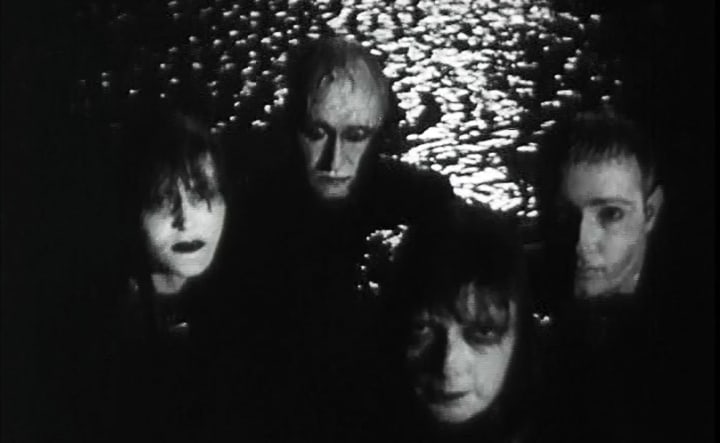Classic Movie Review: 'Carnival of Souls'
Buying a random Criterion Collection DVD based on cool cover art led me to discovering Carnival of Souls.

Carnival of Souls is one of the great anomalies in film history. For many reasons, this movie should not have happened and even if it did get made the chances of it being seen by a mass audience and remembered for 50 plus years is some kind of miracle. Carnival of Souls was conceived by a filmmaker from Lawrence, Kansas, Herk Harvey, who had a minuscule budget and zero experience in anything outside of industrial films and educational film strips.
Had it not been for the inspiration that Herk Harvey took from independent film legend Robert Altman, based on Altman’s proximity, in nearby Kansas City, Missouri, Herk Harvey might never have thought to make an independently funded feature film. Harvey attributed his decision to make Carnival of Souls to the success Altman had garnered with his 1957 feature debut The Delinquents and his successful foray into documentary film-making around his hometown of Kansas City, Missouri.

On a fateful trip to and from California, Herk Harvey came up with the story that would become Carnival of Souls. The specific story inspiration came from seeing the dilapidated and shuttered Saltair Amusement Park in Salt Lake City, Utah, where the most pivotal and memorable scene of Carnival of Souls is set. Sadly, the place where that scene was filmed in 1962 burned down in 1968 but regardless, it was an inspiring sight, sitting empty and creepy in the midst of a barren salt flat. A perfectly inspired setting for a nightmare and one day iconic horror scene.
Carnival of Souls stars the utterly brilliant Candace Hilligoss as Mary Henry, a teenager who nearly loses her life in a car accident that killed two of her friends. Mary somehow survived being submerged in a lake in a car that her friends could not escape from as easily. Mary almost immediately leaves town after the accident and accepts a position as an organist at a small town church. Along the way, Mary continues seeing the strange face of a disembodied soul who appears in windows and mirrors and haunts her dreams.

This creepy, white haired, pallid faced figure appears at random in Mary’s waking daydreams and in her nightmares, all of which lead her to believe she needs to travel to an empty pavilion in the Salt Flats where she hopes the answers to her nightmares may be. Is Mary going crazy from her visions or is she really being menaced by disembodied souls? Are they demons? Are they ghosts? What plans do they have for poor Mary?
Carnival of Souls is one of the great spine chilling creep fests ever made. Herk Harvey may have been an amateur when it came to feature film-making but his instinct for the job is uncanny. Perhaps his time in educational and industrial film was just the right training because his choices of when to hold on a shot, how long to hold, and where to place the camera have a very basic quality but a quality that serves what the story needs. Harvey's instinct for holding on a shot to raise tension, whether intentional or due to lack of experience in feature film-making, gives Carnival of Souls an atmosphere unlike many other movies.

I love the framing of scenes in Carnival of Souls, the lengthy takes, the patient build of each scene. And I especially love the black and white photography which, though it was mostly a budgetary choice, plays perfectly into the dread atmosphere of Carnival of Souls. The face of the character only referred to as ‘The Man,’ and portrayed by director Herk Harvey himself, in an uncredited performance, is made even more ghostly and effective by the lack of color.
Carnival of Souls reaches a film-making crescendo that even great filmmakers would envy. In one of several dream sequences illustrating Mary's fractured psyche, Herk Harvey uses a static camera shot to reveal ghostly figures dancing an endless waltz inside the dilapidated Saltair Carnival. Mary watches in horror as the static camera, staring straight ahead, un-moving, increases the tension as the white faced man steps forward, coming toward her. It’s clearly a dance of the dead and the film's stunning and ominous organ score contributes to the haunting and dread filled atmosphere. These characters have been performing this deathly waltz forever and will forever more.
The choice to bring that scene back for an encore in the final moments of the movie is absolutely brilliant. The rising tension of Mary in this moment is remarkable and as she attempts her escape we can’t help but be filled with the same terror she feels. It’s hard to imagine that a young George Romero didn’t see Carnival of Souls and pull some influence for his eventual triumphant Living Dead franchise. Carnival of Souls has the same eerie dread that Night of the Living Dead delivered six years later, in 1968.
We can thank low watt TV stations across the country, well before the arrival of cable television, for keeping Carnival of Souls alive for so long. The film was bought up by low budget TV stations for Saturday afternoon and late night filler fair and because of that a small but powerful cult formed around the movie. It was that cult that eventually brought Carnival of Souls to the midnight movie circuit of the 70’s and 80’s and eventually to the DVD generation.

Carnival of Souls is now forever apart of the Criterion Collection which assures that anyone in future generations will get to see this remarkable, ingenious and inspiring low budget masterpiece. The Criterion Collection DVD of Carnival of Souls was recently remastered and includes bonus features on how the film was made, information about the remarkable, one time feature director, Herk Harvey, and many other wonderful closer looks at this incredible movie.
Ponder for a moment just how incredible it is that we ever heard of Carnival of Souls. This is a movie made a on a shoestring budget by a no-name filmmaker at a time when the film industry was an even more heavily curated space than it is today. If it hadn't been brilliant while also being used as filler content on independent television stations in the 60's, 70's and 80's, it could have just ended up in a dusty warehouse, moldering away to nothing next to countless other low budget movies. Solely by the fact that the movie is brilliant, creepy, haunting and indelible, it was rescued by fans who shared it with other fans and gave it life that has managed to last to this day. It's a story so great that it makes the experience of Carnival of Souls even more impactful.
I discovered Carnival of Souls while shopping at a local Barnes and Noble store. I was thumbing through their shelves dedicated to movies from the Criterion Collection when the ghostly face of Herk Harvey popped out at me. I turned over to the front of the DVD and saw the incredible art on the cover, as you have seen at the top of this article. I pored over the back cover and was intrigued by the story. Without knowing anything else about it. I bought the DVD and it has become one of the go-to titles of my collection ever since.
There is something truly inspiring in the story of how Carnival of Souls became part of film history. Herk Harvey was a nobody who had one spark of inspiration and through that spark became a legend. He never made another movie and that adds poignancy to the brilliance of this movie. A man of almost accidental talent, the story of Herk Harvey is hope filled. Perhaps there is always a chance that a moment of inspiration could lead you to create a timeless classic. Maybe something that you thought was a failure will one day become something that people will talk about, dissect and remember the rest of their lives. That happened for Herk Harvey, and that, for me, is nearly as exciting and invigorating as the movie Herk Harvey created.
About the Creator
Sean Patrick
Hello, my name is Sean Patrick He/Him, and I am a film critic and podcast host for the I Hate Critics Movie Review Podcast I am a voting member of the Critics Choice Association, the group behind the annual Critics Choice Awards.






Comments
There are no comments for this story
Be the first to respond and start the conversation.